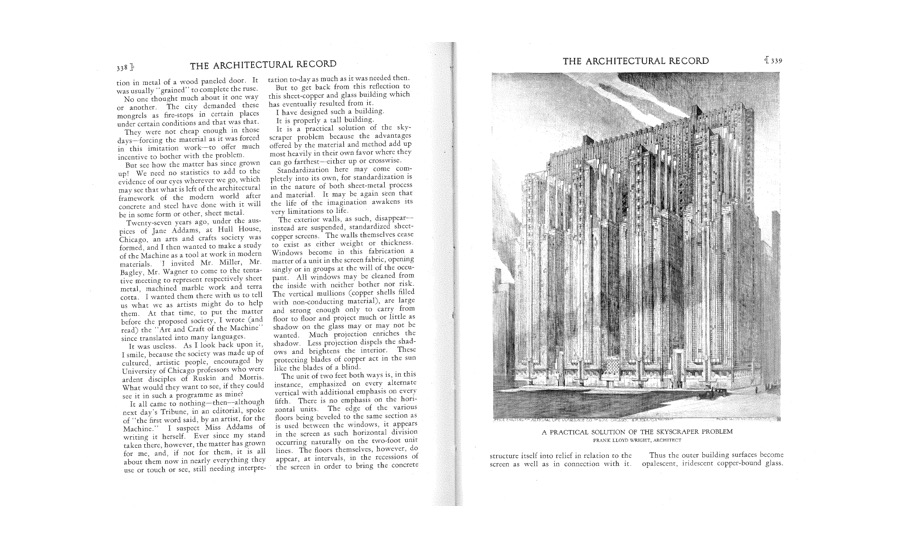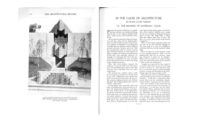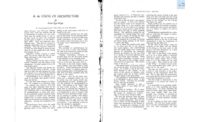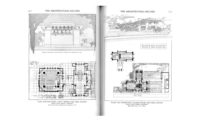From Architectural Record, October, 1928. Read a PDF of the original article here.
The machine is at its best when rolling, cutting, stamping or folding whatever may be fed into it.
Mechanical movements are narrowly limited unless built up like the timer of a Corliss engine or like a linotype.
The movements easiest of all are rotary, next, the press or hammer, and the lift and slide works together with either or both. In these we have pretty much the powers of the “Brute.” But infinite are the combinations and divisions of these powers until we have something very like a brain in action – the Robot itself, a relevant dramatic conception.
The consequences may well be terrifying when man’s volition is added to these brute powers. This volition of man’s, deprived of soul, may drive these powers to limit of human endurance, yet – to the ultimate extinction of the humanity of the race.
Commerce, as we have reason to know, has no soul.
Commercial interests left to themselves would soon write their own doom in the exploitation of their own social life. They would soon cease to reproduce. They would fail to reproduce because the elements of commerce are those of the machine – they lack the divine spark necessary for giving life. The margin of profit, piling up into residue, is inert, inept, impotent.
The Machine itself represents this margin of profit in the physical body of our modern world: a profit, inept, inert, impotent.
The question propounded in these papers and the continual haunting reference in all of them – “What is this interpreter of life, the Architect, going to do about it,” - is again insistent here. For in sheet metal there is opportunity to give life to something the Architect seems to despise his forced to use it because it is cheap. He avails himself of it as a degraded material. In the building trade, we find cornices, gutters, downspouts, water-sheds, in led, zinc and tin, iron and copper, everywhere. Imitations too in these materials, of very other material, are everywhere.
But where may sheet metal be seen used as a fine material for its own sake?
Oh yes, occasionally. But why not “everywhere.” It is the one “best thing” in modern economy of materials brought by the Machine. Building trades aside, we now make anything at all of sheet metal – kitchen utensils, furniture, automobiles and Pullman coaches. And in flashings and counter flashings or roofing it is keeping nearly all the citizens of America dry in their homes at the present moment.
Copper is easily kind of this field and what is true of copper will be true also of the other metals in some degree, with certain special aptitudes and properties added or subtracted in the case of each.
Back of this sheet metal tribe, literally, we have the light rolled steel section for stiffening any particular sheet metal area in all particular cases whatsoever. All “spread” materials need reinforcement. Metal sheets no less than concrete slabs.
In the building trades we have had recourse to these metal fabrics in the cheapest and most insulting fashion, in buildings where the architect has either never been seen, or has been set aside. Sheet metal is prime makeshift to his highness the American jerry-builder.
Roofs seem to be the building problem naturally solved by sheet metal, as it may be stamped into any desired form, lock scammed, and made into a light, decorative and permanent water-shed. It is possible to double the thickness in long panels or channels, sliding non-conducting material between them and lock-seaming together the continuous slabs thus made so that they lie together like planks on the roof framing, finished from below as from above. Each slab is a natural water channel.
The machinery at work in the sheet metal trades easily crimps, folds, trims and stamps sheets of metal as an ingenious child might his sheets of paper. The finished product may have the color brought up in surface treatment, or be enameled with other substances as in enamel color glazing or plating, or by galvanizing the finished work may be dipped and coated entire. But copper is the only sheet metal that has yet entered into architecture as a beautiful, permanent material. Its verdigris is always a great beauty in connection with stone or brick or wood, and copper is more nearly permanent than anything we have at hand as an architect’s medium.
But now that all metals may be rolled into sheets and manipulated so cheaply – combinations of various metals may be made as any other combination of materials may be. And will be.
The Japanese sword-guard shows how delightful these properties of metal become when contrasted and harmonized in the hands of a master-artist. A collection of these mighty little things in art and craft should be the vade-mecum of every metal student or worker. In fact it seems that upon metals the Japanese, and before them the Chinese, have lavished much of their genius and have excelled from the making of a keen cutting-blade that would hold its edge against blows on steel to inventing subtle texture-treatments in iron for all decorative purposes.
Leaving the precious metals in a category by themselves, these sympathetic treatments of various humble metals are most significant for us who, as masters of metal production, are committed to it in our industries, though we have developed the beauty of it in use not at all. In previous ages, beyond the roofer’s use of lead in roofing and water-leads and the blacksmith’s wrought-iron as seen in gates and lanterns, there has been little use made of metal by architects excepting such occasional use of bronze as Ghiberti made in his famous doors. But Ghiberti was a sculptor, not an architect, or his doors would, probably, have been wood elaborately ironed in the mode.
I believe the time is ready for a building of sheet copper wherein the copper may be appropriate carriage for glass only. What would such a building be good for and what would it be like?
Why should we have such buildings? This architect will try to answer in his own fashion.
Since first meeting, thirty years ago, James A. Miller, a sheet-metal worker of Chicago, who had intelligence pride in his material and a sentiment concerning it (designing a house for himself at one time he demanded a tin-floored balcony outside his bedroom window in order that he might hear the rain patter upon it), I have had respect for his sheet-metal medium.
At that time I designed some sheet copper bowls, slender flower holders and such things, for him, and fell in love with sheet copper as a building material. I had always liked lead, despised tin, wondered about zinc, and revolted against galvanized iron as it was then used in Chicago quite generally as a substitute for granite.







